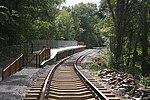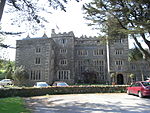Cann Quarry Canal
Canals in DevonCanals opened in 1829Geographic coordinate listsIndustrial archaeological sites in DevonLists of coordinates ... and 1 more
Use British English from March 2017

The Cann Quarry canal was a canal in Devon, England which ran for just under 2 miles (3.2 km) from Cann Quarry to the River Plym at Marsh Mills. It opened in 1829, and a short tramway connected it to the Plymouth and Dartmoor Railway at Crabtree Junction. It had been replaced by a tramway within ten years, but continued to be used as a mill leat to supply Marsh Mills corn mill, and most of it is still visible.
Excerpt from the Wikipedia article Cann Quarry Canal (License: CC BY-SA 3.0, Authors, Images).Cann Quarry Canal
Plym Valley Trail, Plymouth Leigham
Geographical coordinates (GPS) Address Nearby Places Show on map
Geographical coordinates (GPS)
| Latitude | Longitude |
|---|---|
| N 50.407 ° | E -4.083 ° |
Address
Plym Valley Trail
Plym Valley Trail
PL7 4NW Plymouth, Leigham
England, United Kingdom
Open on Google Maps





